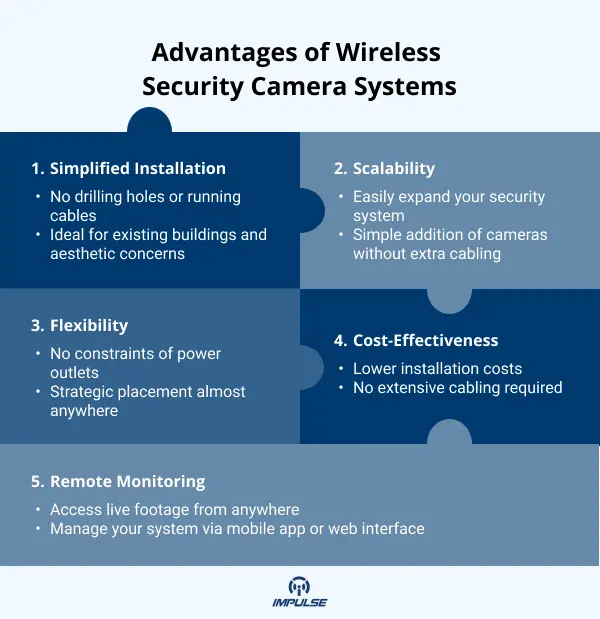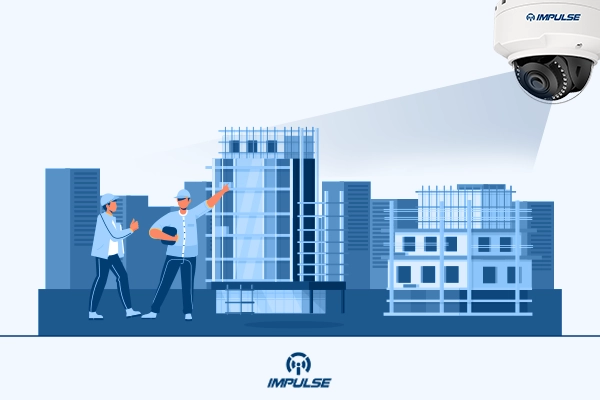In today’s business landscape, security is paramount. Protecting your employees, inventory, and property from theft, vandalism, and other threats is crucial for a successful operation. Wireless security camera systems have emerged as a popular choice for commercial projects due to their ease of installation, flexibility, and cost-effectiveness compared to traditional wired systems.
This comprehensive guide, delves into the world of wireless security camera systems for commercial applications. We’ll equip you with the knowledge and confidence to navigate the installation and maintenance process, ensuring your system functions optimally and delivers the peace of mind you deserve.

Also Read: Securing Your Investment: Implementing Security Cameras on Construction Sites
- Simplified Installation: Gone are the days of drilling holes and running cables through walls. Wireless systems eliminate the need for extensive construction work, making them ideal for existing buildings or situations where aesthetics are a concern. The installation process of is not only quicker but also less disruptive, allowing for a more seamless integration into your environment.
- Scalability: Expanding your security system becomes a breeze. Adding additional cameras to accommodate growth or changes in your layout is a simple process compared to wired systems that require additional cable runs. This makes wireless systems particularly suitable for businesses that are rapidly expanding or undergoing frequent layout changes.
- Flexibility: Wireless cameras free you from the constraints of power outlets. They can be strategically placed almost anywhere within your property, providing a comprehensive view of your space. This flexibility ensures that blind spots are minimized and security coverage is maximized, adapting to various architectural designs and specific security needs.
- Cost-Effectiveness: Lower installation costs due to the absence of extensive cabling contribute to a more budget-friendly security solution. Additionally, the reduced need for ongoing maintenance and the ability to easily reconfigure the system without significant expenses make wireless systems a long-term cost-effective choice.
- Remote Monitoring: Access live footage and manage your system from anywhere with an internet connection using a mobile app or web interface. This allows you to stay vigilant and take action even when you’re away from your business. The convenience of remote monitoring ensures that you can respond to security alerts promptly, enhancing the overall safety of your premises.
Also Read: Choosing Between NVR and DVR for Your Security Camera System
Choosing the Right System for Your Needs
Selecting the ideal wireless security camera system for your commercial project hinges on several key factors that need to be carefully considered to ensure comprehensive coverage and functionality:

- Number of Cameras: When deciding on the number of cameras, take into account the size and layout of your property. Strategically placed cameras should cover all entryways, exits, critical areas like cash registers, and potential blind spots. It may be beneficial to conduct a thorough site assessment to identify all areas that require monitoring.
- Video Quality: The resolution of your cameras is crucial for capturing clear and identifiable details. High-definition (HD) cameras provide good image quality, which is usually sufficient for general surveillance needs. However, if you require even greater detail, especially for identifying faces or small objects, 4K cameras offer exceptional clarity, making them ideal for zooming in on critical details. Additionally, night vision capabilities are essential for capturing activity in low-light conditions, ensuring 24/7 surveillance.
- Weatherproofing: For outdoor installations, it is imperative to ensure that the cameras are weatherproof and can withstand your region’s temperature extremes, precipitation, and dust. Look for cameras with a high IP rating, which indicates their level of protection against solid particles and moisture. This ensures that your surveillance system remains operational regardless of the weather conditions.
- Storage Options: When it comes to storing the footage, you have several options. Cloud storage offers easy remote access and offsite backup, which can be incredibly convenient, but it may incur monthly fees. On the other hand, local storage on a hard drive is a cost-effective option that eliminates recurring costs but requires a physical device onsite and carries the risk of physical damage or theft. It’s essential to weigh the pros and cons of each option based on your specific needs and budget.
- Power Source: The power source for your cameras is another critical consideration. Battery-powered cameras provide greater flexibility in placement since they are not tethered to a power outlet, but they require periodic battery changes, which can be a hassle. Continuous power with PoE (Power over Ethernet) offers a reliable solution, providing both power and data connection through a single cable. However, this setup necessitates a nearby power outlet or PoE switch, which might limit placement options.
Also Read: Top 5 Outdoor Network Cameras for Businesses: Deter Crime and Monitor Property
Preparation
- Planning Camera Locations: Carefully consider your security needs and identify blind spots. Utilize a floor plan to map out camera placement, ensuring a comprehensive view of all critical areas. Think about entry points, windows, and any other places that might be vulnerable. Make sure to cover every angle to avoid any potential blind spots.
- Wi-Fi Signal Strength: Wireless cameras rely on a strong Wi-Fi signal for optimal performance. Conduct a Wi-Fi signal strength test at potential camera locations to avoid connectivity issues. If the signal is weak, the camera may not function properly, leading to gaps in your security coverage. Consider adding Wi-Fi extenders if necessary to boost the signal strength and ensure reliable operation.
- Mounting Considerations: Choose appropriate mounting hardware based on the camera type (wall, ceiling, pole) and ensure a stable and secure installation. The mounting location should be sturdy to prevent the camera from shaking or falling. Additionally, think about the camera’s field of view and try to mount it at an angle that maximizes coverage.
Installation
- Follow the Manufacturer’s Instructions: Each camera model may have slight variations in the installation process. Always refer to the manufacturer’s instructions for your specific camera system. These instructions will guide you through the necessary steps and provide tips to ensure a smooth installation.
- Pairing Cameras: Pair each camera with the base station or NVR (Network Video Recorder) according to the manufacturer’s instructions. This process typically involves scanning a QR code or manually entering a pairing code. Ensure that each camera is correctly paired to avoid any issues with video feeds or recording.
- Testing Functionality: Once paired, thoroughly test each camera. Verify video quality, night vision effectiveness, and audio functionality (if applicable). Test the cameras under different lighting conditions and from various angles to ensure they meet your security needs. Make any necessary adjustments to optimize performance.
System Setup
- Network Connection: Connect the NVR or base station to your network using an ethernet cable. Ensure it has a secure internet connection for remote monitoring. A stable internet connection is crucial for accessing live footage and recorded videos from remote locations.
- Recording Settings: Configure recording schedules and motion detection zones. Customize recording settings based on your needs; continuous recording, motion-triggered recording, or specific timeframes. Adjust sensitivity settings to minimize false alarms and ensure important events are captured.
- Mobile App: Download and set up the mobile app for remote access. Most systems offer dedicated apps for both iOS and Android devices. Follow the app’s instructions to connect to your system and access live footage. The app will allow you to monitor your security system from anywhere, receive alerts, and review recorded footage conveniently.
Maintaining Your System for Optimal Performance
Regular maintenance is vital to ensure your wireless security camera system operates at peak efficiency. Here are key practices:
- Regular Cleaning: Clean camera lenses with a microfiber cloth at least once a month to remove dust, dirt, and cobwebs that can obstruct image quality.
- Battery Replacements (if applicable): For battery-powered cameras, replace batteries according to the manufacturer’s recommendations. Battery life can vary depending on usage, recording settings, and weather conditions.
- Firmware Updates: Install firmware updates from the manufacturer when available. These updates often include bug fixes, security patches, and improved functionality for your cameras.
- Testing and Troubleshooting: Regularly test your cameras and system functionality. Check for recording issues, connectivity problems, or any changes in video quality. Consult the user manual or manufacturer’s website for troubleshooting steps.
Conclusion
Wireless security camera systems offer a compelling solution for businesses seeking a robust and user-friendly security solution. These systems provide not just basic surveillance but also advanced features that enhance overall security management. Their ease of installation eliminates the need for extensive wiring, reducing setup time and costs. Additionally, the scalability of these systems allows businesses to expand their security networks as needed, accommodating growth and changes in security requirements. The remote monitoring capabilities enable business owners and security personnel to keep an eye on their premises from anywhere, ensuring constant vigilance. These attributes make wireless security camera systems ideal for commercial applications of all sizes, from small retail stores to large corporate offices and industrial facilities.
Impulse CCTV is dedicated to providing you with the resources and knowledge necessary to secure your business effectively. By understanding the benefits and considerations when choosing a wireless security camera system, you can ensure optimal performance and peace of mind.
Unsure which wireless security camera system suits your commercial project? Impulse CCTV is here to help! Contact us today and we’ll assess your security needs, recommend the ideal system for your property, and guide you through the installation process.


